Seasonal Maintenance Tips for Solar Panels
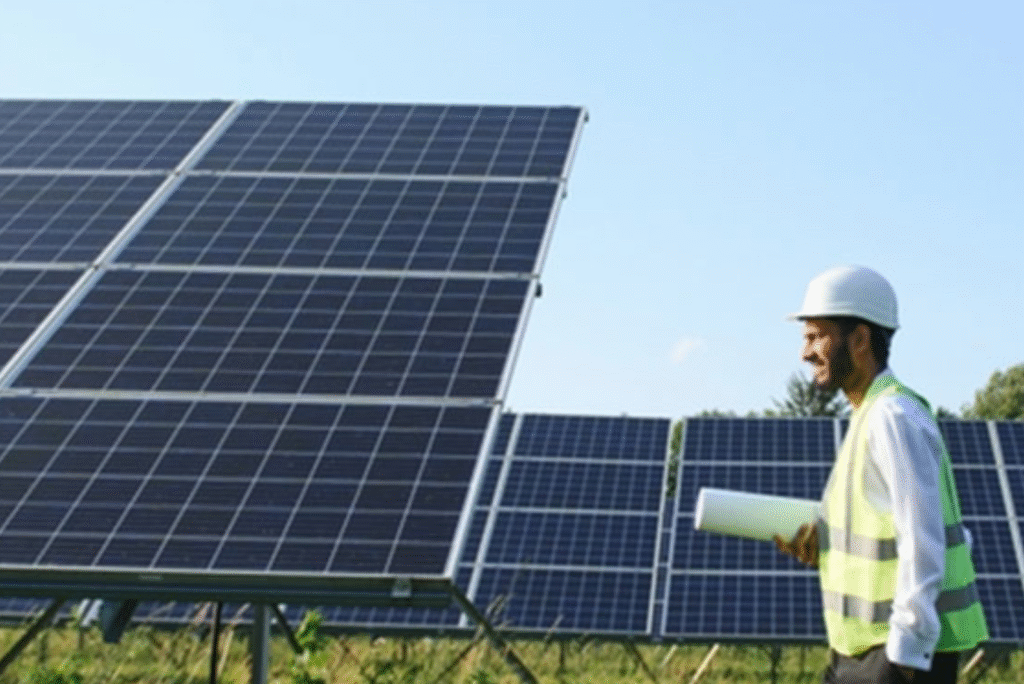
Seasonal Maintenance Tips for Solar Panels Home Blogs Popular Posts All Posts Blog Seasonal Maintenance Tips for Solar… October 6, 2025 Solar Water Pump vs Regular… October 6, 2025 Rooftop Solar vs Ground-Mounted Solar October 6, 2025 Choosing the Best Solar Panel… October 6, 2025 Power Your Future with KLK Ventures Pvt. Ltd. Delivering reliable solar solutions for a sustainable tomorrow. Switch to clean energy and save with us today. Contact US Keeping your solar panels efficient and long-lasting takes a bit of work and that work changes with the seasons. This guide on solar panel maintenance tips walks you through simple, effective steps every homeowner can take throughout the year. Think of it as a friendly checklist you can actually follow, not technical jargon. Why Seasonal Maintenance Matters Solar panels are exposed to sun, rain, dust, and even snow. Small issues like dust buildup or loose wiring, can slowly drop your energy production. By tuning into seasonal changes, you help your system stay efficient and safe, year after year. Spring: Start Fresh and Inspect Carefully Spring is all about cleaning up after the rough weather of winter. Inspect for Winter WearLook for cracks, chips, or loose connections. Winter’s freeze-thaw cycles can weaken panels or mountings. Clean Off DebrisRemove pollen, bird droppings, or dust that settled over winter. Use a soft brush or a hose with gentle water to avoid scratches. Trim Nearby PlantsSpring foliage grows fast and can cast shadows. Trim trees or bushes so your panels soak up sun all day. Check Wiring and MountsAnimals sometimes scamper under panels in winter. Look for loose wiring, rodent damage, or fastener issues. Summer: Stay Cool and Dust-Free Summer brings intense sun and in dry places like ours, dust and heat can sneak in. Clean SmartlyDust and droppings gather quickly under dry, hot skies. Clean panels in the early morning or evening and avoid midday heat to prevent thermal stress. Watch for OverheatingHigh temperatures and poor airflow can reduce efficiency. Make sure there’s space for air to circulate beneath panels. Monitor OutputSummer is your highest production season. Keep an eye on performance, if it dips, dirty panels may be the culprit. Prevent Wildlife BuildupBirds and small animals might build nests under panels for shade. Check and remove any nests or debris regularly. Monsoon (or Rainy Season): Clean and Protect Depending on your region, especially in India, rain brings both washing and mess. Rinse Off Mud and Rain MarksPost-rain, panels may carry streaks or mud. Gently wipe them clean with water and a soft cloth. Clear Gutters and DrainageEnsure water doesn’t pool around the mounting frames. Proper drainage avoids moisture buildup. Check Electrical ComponentsHumidity or water might seep into junction boxes or inverters. Keep them dry, sealed, and corrosion-free. Prune Vegetation and Remove DebrisStorms may drop leaves or branches. Clear them promptly to keep sunlight flowing freely. Autumn (Fall): Prepare for Winter Ahead As days shorten, autumn is your prep time for harsher weather. Remove Leaves and DebrisFallen leaves can trap moisture, cause shading, or breed mold. Use a blower or soft brush to clean panels. Trim Overhanging BranchesWith shifting sun angles, even bare branches can cast long shadows. Keep nearby foliage trimmed. Secure Mounts and SealsTemperature swings can loosen fasteners or crack weatherproof seals. Check locks, bolts, and seals now, before winter arrives. Document Performance BaselinesRecord your system’s output now. It’s easier to spot any winter dips by comparing autumn data. Winter: Keep Your Panels Safe and Dry Winter brings unique challenges like snow, ice, and cold. Remove Snow GentlyUse a soft-bristle brush or a special solar panel snow rake. Avoid hot water or harsh tools, the sudden temperature or impact can crack the glass. Watch for Ice DamageIce can form around edges, stressing panels. Carefully remove it and inspect for cracks or mount damage. Track Winter PerformanceShorter days and snow block light. If output drops more than expected (say, 20% below normal winter levels), check for issues or schedule a pro inspection. Protect Components and CablingCold temperatures can damage batteries or wiring. Ensure they’re in weather-protected enclosures. How Often Should You Clean? Frequency depends on your climate and environment: Urban areas (pollution, dust): clean every 3–6 months. Arid/dusty zones: every 1–3 months Coastal areas (salt spray): every 6–12 months, rinse after storms Temperate climates: every 3–4 months; more after autumn and spring events India (dry/monsoon): at least twice a year, more if dust storms or heavy pollution; 1–2 months cleaning in dusty seasons. Seasonal Solar Panel Maintenance Checklist Keeping your solar panels clean and efficient doesn’t have to be hard. Here’s a quick, seasonal breakdown of what to do: Spring Clean off pollen, dust, and bird droppings Inspect for cracks, loose wires, or winter damage Trim any growing plants that could cast shade Summer Wash panels early morning or late evening to avoid heat stress Remove dust, debris, and any bird nests Ensure airflow under panels to prevent overheating Monsoon Clear mud, leaves, and storm debris after rain Check for proper drainage around mounts Inspect junction boxes and wiring for moisture or rust Autumn Remove fallen leaves and trim overhanging branches Secure mounts and check for weather seal damage Record current output for winter comparison Winter Gently remove snow or ice with a soft brush Protect cables and batteries from freezing Monitor performance for sudden output drops Final ThoughtGood solar panel maintenance tips don’t just preserve energy but they protect your investment. By adjusting your care seasonally, you keep your system efficient, reliable, and problem-free. Whether you’re cleaning off monsoon muck, brushing snow in winter, or checking mounts in autumn, each small effort helps your panels perform their best through the year.
Solar Water Pump vs Regular Pump: Pros and Cons

Solar Water Pump vs Regular Pump: Pros and Cons Home Blogs Popular Posts All Posts Blog Seasonal Maintenance Tips for Solar… October 6, 2025 Solar Water Pump vs Regular… October 6, 2025 Rooftop Solar vs Ground-Mounted Solar October 6, 2025 Choosing the Best Solar Panel… October 6, 2025 Power Your Future with KLK Ventures Pvt. Ltd. Delivering reliable solar solutions for a sustainable tomorrow. Switch to clean energy and save with us today. Contact US Water pumps move water. That’s obvious, but the way they do it, how they get their energy, and what that means for your wallet and the planet, that’s where things get interesting. In this post, I’ll break down “solar water pump vs regular pump” in a friendly, clear, and helpful way. What are Solar Water Pumps and Regular Pumps? These pumps run mostly or entirely on power from the sun. They use solar panels to collect sunlight, which turns into electricity to run the pump. No electricity bills. Often used in remote farms, gardens, or places without reliable power. Regular PumpsThese are what people usually mean by “ordinary” pumps. They use grid electricity, diesel, or petrol to pump water from wells, rivers, or storage tanks. You see them all the time like watering lawns, filling swimming pools, or in factories Energy source: Sun versus fossil fuel or grid electricity. Cost: Up‑front investment versus running costs. Maintenance: Panels and electronics versus engines and fuel. Reliability: Weather dependency versus consistency. Environmental impact: Clean energy versus emissions. Pros of Solar Water Pumps1. Lower Operating CostsOnce you buy and install the solar water pump, the sun does the job for free. Over time, that can mean huge savings compared to paying for electricity or fuel. 2. Eco-Friendly and SilentNo smoke. No noise. Just sun. Solar pumps are clean energy champions. 3. Cost Predictability and IndependenceYou don’t worry about leaking grid power or rising electricity prices. And if your farm is far from towns or a power line, solar saves you from paying for new cables or waiting for electrification. 4. Low MaintenancePanels typically need cleaning now and then. The pump has fewer moving parts than an engine. That means fewer breakdowns and less tinkering. 1. Up‑Front Costs Buying solar panels, controllers, and a suitable pump costs more initially than a simple electric or diesel pump. But that cost can pay off over time. 2. Weather Dependency No sun? No pump. Cloudy days or rain can slow or stop water delivery. 3. Energy Storage Needs If you need water at night or early morning, you’ll want batteries or storage tanks. Batteries add cost and upkeep. 4. Limited Power for High Head Applications “Head” means vertical lift. Solar pumps are often great for low–medium lifts, like watering a garden or small field. But if you’re trying to pump water dozens of feet up or far away, they may need more panels and stronger investments. Pros of Solar Water Pumps 1. Lower Operating CostsOnce you buy and install the solar water pump, the sun does the job for free. Over time, that can mean huge savings compared to paying for electricity or fuel. 2. Eco-Friendly and SilentNo smoke. No noise. Just sun. Solar pumps are clean energy champions. 3. Cost Predictability and IndependenceYou don’t worry about leaking grid power or rising electricity prices. And if your farm is far from towns or a power line, solar saves you from paying for new cables or waiting for electrification. 4. Low MaintenancePanels typically need cleaning now and then. The pump has fewer moving parts than an engine. That means fewer breakdowns and less tinkering. Pros of Regular Pumps 1. Up‑Front CostsBuying solar panels, controllers, and a suitable pump costs more initially than a simple electric or diesel pump. But that cost can pay off over time. 2. Weather DependencyNo sun? No pump. Cloudy days or rain can slow or stop water delivery. 3. Energy Storage NeedsIf you need water at night or early morning, you’ll want batteries or storage tanks. Batteries add cost and upkeep. 4. Limited Power for High Head Applications“Head” means vertical lift. Solar pumps are often great for low–medium lifts, like watering a garden or small field. But if you’re trying to pump water dozens of feet up or far away, they may need more panels and stronger investments. Pros of Regular Pumps 1. ReliabilityThey run anytime, through heat or rain, day or night, as long as fuel or electricity is available. 2. Lower Initial CostA small electric or diesel pump can be purchased and installed for far less money than a solar system. 3. Good for High Pressure or Big JobsIf you need to move large volumes quickly or pump to large heights, a well-sized gasoline or electric pump can be more efficient and cost-effective up-front. Cons of Regular Pumps 1. Operating Costs Add UpFuel prices rise. Grid prices fluctuate. Over time, you might spend far more than the pump’s cost. Insight: In my friend’s village, a diesel pump’s monthly fuel cost shot up 40% after a fuel-tax hike. Solar would’ve been a steady expense instead. 2. Noise and PollutionDusty diesel engines may make the water smell funny. Electric pumps are quieter, but still depend on dirty grid power in many places. 3. Maintenance and BreakdownsEngines need oil changes, spark plugs, filters. Electric pumps sometimes suffer motor burns or wiring issues. That adds hassle and repair bills. 4. Fuel Storage HasslesStoring petrol or diesel safely requires secure containers, reminding you that you also need to think about safety and spills around. Quick Comparison: Solar Water Pump vs Regular Pump 1. Operating CostSolar: Almost zero after installation as sunlight is free. Traditional: Ongoing costs for fuel or electricity. 2. Initial CostSolar: Higher up-front due to panels and setup. Traditional: Cheaper to buy and install. 3. MaintenanceSolar: Low: just clean the panels occasionally. Traditional: Moderate to high, requires fuel, oil changes, and repairs. 4. ReliabilitySolar: Sun-dependent; may slow down on cloudy days. Traditional: Works anytime with fuel or power
Rooftop Solar vs Ground-Mounted Solar
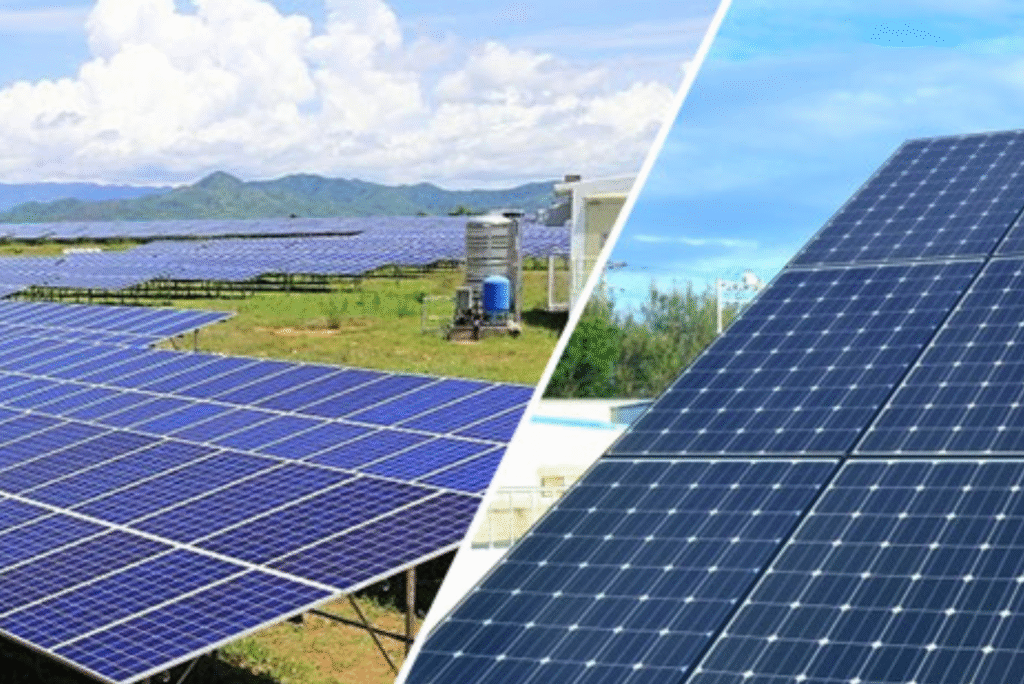
Rooftop Solar vs Ground-Mounted Solar Home Blogs Popular Posts All Posts Blog Seasonal Maintenance Tips for Solar… October 6, 2025 Solar Water Pump vs Regular… October 6, 2025 Rooftop Solar vs Ground-Mounted Solar October 6, 2025 Choosing the Best Solar Panel… October 6, 2025 Power Your Future with KLK Ventures Pvt. Ltd. Delivering reliable solar solutions for a sustainable tomorrow. Switch to clean energy and save with us today. Contact US If you’re thinking about installing solar panels, you’re already on the right path. Solar energy is clean, reliable, and in the long run, way cheaper than traditional electricity. But here’s a common question most people ask before going solar: “Should I go for rooftop solar or ground-mounted solar?” Choosing between rooftop and ground-mounted solar isn’t just about space. It depends on your property, budget, energy goals, and future plans. This guide will help you understand the pros, cons, and best use cases for each. What’s the Difference? Rooftop solar systems are installed directly on your building’s roof—residential, commercial, or industrial. Ground-mounted solar systems are installed on the ground, usually on open land beside or near the building. Both systems use the same core technology—solar panels, inverters, and wiring—but differ in setup, cost, and optimization options. Benefits of Rooftop Solar Efficient use of space: Utilizes your existing roof area. Lower installation cost: Requires fewer mounting materials. Net metering ready: Sell extra power back to the grid. Subsidies: Eligible under the PM Surya Ghar Yojana for home systems. Limitations Limited space for larger capacity systems. Shading from nearby structures or trees can reduce efficiency. Roof condition may require reinforcement. Benefits of Ground-Mounted Solar No roof limitations—install more panels based on land size. Optimized orientation and tilt for better sun exposure. Easier maintenance—no climbing required. Easy to expand system in the future. Limitations Requires open land, which can be costly in urban areas. Higher setup costs due to additional structure and foundation work. May need land-use permissions for agricultural land. Rooftop Solar Rooftop solar is the preferred option for homes and most small businesses. It makes use of existing roof space and involves less civil work. Installation is typically quicker and more affordable, especially with government subsidies like the PM Surya Ghar Yojana (for systems under 10kW). Lower installation costs Eligible for government subsidies (up to 10kW) Quick setup using existing infrastructure Annual savings can range from 70% to 90%, depending on usage Limitations: roof space and shading may restrict performance or expansion Ground-Mounted Solar Ground-mounted solar is ideal for property owners with available land that receives ample sunlight—like factories, farms, and educational institutions. These systems offer more flexibility in orientation and tilt, leading to better energy capture and easier maintenance. Higher scalability for large systems (20kW+) Optimized sun exposure due to flexible panel positioning Easier maintenance and cleaning access Generally more expensive due to land prep and mounting structures Not eligible for home subsidies, but commercial owners benefit from tax savings and accelerated depreciation In Summary: Use rooftop solar if your roof gets good sunlight and you want to save space and money. Choose ground-mounted solar if you have land and need a larger, high-output system. Choose Rooftop Solar if: You live in a city with limited land space. Your roof is structurally strong and unshaded. You want a system between 1–10kW for home or small business. You want to claim net metering and government subsidy. Choose Ground-Mounted Solar if: You own extra land near your property (like farms or factories). You’re installing a high-capacity system: 20kW, 50kW, or more. Your roof is shaded, weak, or already occupied (water tanks, etc.). You’re building a solar farm or export-oriented solar setup. Permissions Rooftop systems need DISCOM approvals for net metering. Ground-mounted systems may require land-use permissions. Solar EPC providers usually handle the paperwork. Maintenance Both setups need regular cleaning, especially in dusty regions (like Rajasthan or Gujarat).Ground-mounted systems are easier to access for cleaning and repair.Annual Maintenance Contracts (AMCs) are recommended for longevity.Cost Comparison: Rooftop vs Ground-Mounted (2025)Rooftop Solar (1–10kW): ₹45,000 – ₹65,000 per kW (before subsidy)Ground-Mounted Solar (10kW+): ₹50,000 – ₹70,000 per kW Final Thoughts: Which One Should You Choose? City homeowner? Rooftop is likely your best choice. Factory owner with land? Go ground-mounted for higher output. Farmer with land? Consider solar farms or hybrid systems. School or apartment? Explore shared rooftop solar. No matter your choice, going solar in 2025 is one of the smartest long-term investments—for your wallet and the planet.
Choosing the Best Solar Panel Company This Year

Choosing the Best Solar Panel Company This Year Home Blogs Popular Posts All Posts Blog Seasonal Maintenance Tips for Solar… October 6, 2025 Solar Water Pump vs Regular… October 6, 2025 Rooftop Solar vs Ground-Mounted Solar October 6, 2025 Choosing the Best Solar Panel… October 6, 2025 Power Your Future with KLK Ventures Pvt. Ltd. Delivering reliable solar solutions for a sustainable tomorrow. Switch to clean energy and save with us today. Contact US Switching to solar in India is one of the best decisions you can make in 2025. As electricity prices rise and power cuts become more frequent, in addition to being more aware of climate change, more homes and businesses in India are now switching to solar power. But here’s the catch: there are hundreds of solar companies in India, and not all of them are equal. Some promise the moon but deliver poor service or unreliable panels. So, how do you find the best solar panel company in 2025 in India? Why Choosing the Right Solar Company in India Matters A solar panel installation is a long-term commitment. You are buying equipment but maybe even more so, you are trusting a company to deliver what should be a reliable installation for 25 years or more. Choosing the wrong company may mean: Unreliable performance in the heat or rainy seasonSystem breakdowns and poor after-sales supportLosing out on government subsidies or warrantiesThat’s why finding the best solar panel company in 2025 is so important — it ensures real savings, peace of mind, and long-term value. 1. Understand Your Energy NeedsBefore approaching any solar provider, take a moment to understand your current and future needs. Ask yourself: What’s my average electricity bill?Is my roof suitable for solar panels? (flat, sloped, shaded?)Do I need an on-grid, off-grid system, or hybrid system?Should I consider a battery backup for power cuts?Do I qualify for a government subsidy?2. Choose a Company With Local ExperienceSolar is not a one-size-fits-all solution. What works in Maharashtra may not work in Himachal Pradesh. You should select a company that: Has installed systems in your city or stateUnderstands your DISCOM’s net metering policyIs familiar with your local weather and rooftop scenario3. Check Certifications and ComplianceIn India, solar quality can vary a lot. You must ensure your installer and equipment meet official standards. Look for: MNRE-empanelled companyALMM-listed panelsISO 9001/14001 certificationState-wise contractor or electrical licenseProper GST billing and documentation4. Compare Equipment QualityDon’t go by price alone, ask which brands of panels and inverters they’re offering. Reliable brands include: Panels: Tata Power Solar, KLK Ventures, Waaree, Adani, LONGi, TrinaInverters: Fronius, Solis, Growatt, Sungrow, Luminous (for off-grid)Batteries: LFP or tubular batteries from trusted manufacturersWarranty checklist: Panel performance: 25 yearsInverter: 5–10 yearsWorkmanship: 5 years or more5. Ask for Reviews and Real ReferencesDon’t use only their website. Look for independent reviews. Where to check: Google Reviews (with your city name)Solar comparison sites like SolarSquare or ZunRoofYouTube testimonials (search with “installation review + city”)Example: A Surat resident found a solar vendor with 4.9 stars on Google. Only later did they find out the company outsourced everything to local electricians who weren’t accountable. Always ensure you ask if the installer is in-house or outsourced. 6. Understand Financing and SubsidiesSolar systems cost ₹50,000–₹70,000 per kW in 2025. Fortunately, there are many ways to reduce the upfront cost: PM Surya Ghar Yojana: Central government scheme offering subsidies up to ₹78,000 for homesState subsidies: Gujarat, Kerala, Tamil Nadu, etc.Solar loans: From SBI, HDFC, L&T Finance, etc.EMIs: From private companies7. Get 2–3 Quotes and CompareDon’t just settle with the first company. Obtain detailed quotes from three or more vendors. Then compare: Brands and specifications of equipmentInstallation timelinesWarranty and after-sales serviceSupport with subsidy and net metering8. Ask About After-Sales Service and MonitoringYour system could face issues, especially during the monsoon or voltage fluctuations. Make sure you have support. Questions to ask: Do you have an app-based performance monitoring service?Who does the repairs and how fast?Is there a helpline or service number?9. Read Contracts CarefullyPrior to signing anything, go through the proposal line by line. Look for: Itemised equipment listTotal system cost (before and after subsidy)Payment scheduleWarranty terms in writingNet metering & subsidy process responsibilityPro Tip: If they mention a date for installation completion, ask them to mention penalties if they don’t meet that deadline. 10. Watch for These Red FlagsHere are a few indicators that a company may not be reliable: “Free stuff!” or “No payments for 12 months!”No identified location or contact info on their websitePushing you to sign quickly without clear explanationNo written warranty or ALMM approvalLarge upfront payment without documentation Over 30 Years of Industry Experience KLK Ventures, originally K.L. Khanna Gears Industries, has over 30 years of experience and has built trust through high-performance solutions across sectors. Diversified into Solar, Storage, and Energy Efficiency Under the leadership of visionary CEO Akshat Jain, KLK Ventures now offers: Solar power systems Advanced energy storage technologies Energy-efficient lighting systems They’ve earned praise from government bodies, PSUs, and private sector clients for their reliability and performance. In-House Battery Plant & Testing Facility Since 2018, KLK Ventures has run a modern battery manufacturing and R&D facility. This in-house control ensures better quality, innovation, and service. National Presence – Manufacturing from Noida and Bihar With factories in Noida and Bihar, KLK Ventures can support large-scale commercial solar projects across India. Consultancy + Implementation KLK doesn’t just install panels — they offer: Energy audits Performance monitoring Custom rooftop designs Complete solar + storage solutions Our Future Green Vision KLK Ventures is committed to reducing India’s carbon footprint and enabling a cleaner, greener energy future with affordable, high-quality solar technologies. Final Checklist: How to Choose Right Before finalising a solar partner, make sure you: Know your energy usage Choose an MNRE-approved vendor Compare brands and warranties
Solar Policy 2025 India
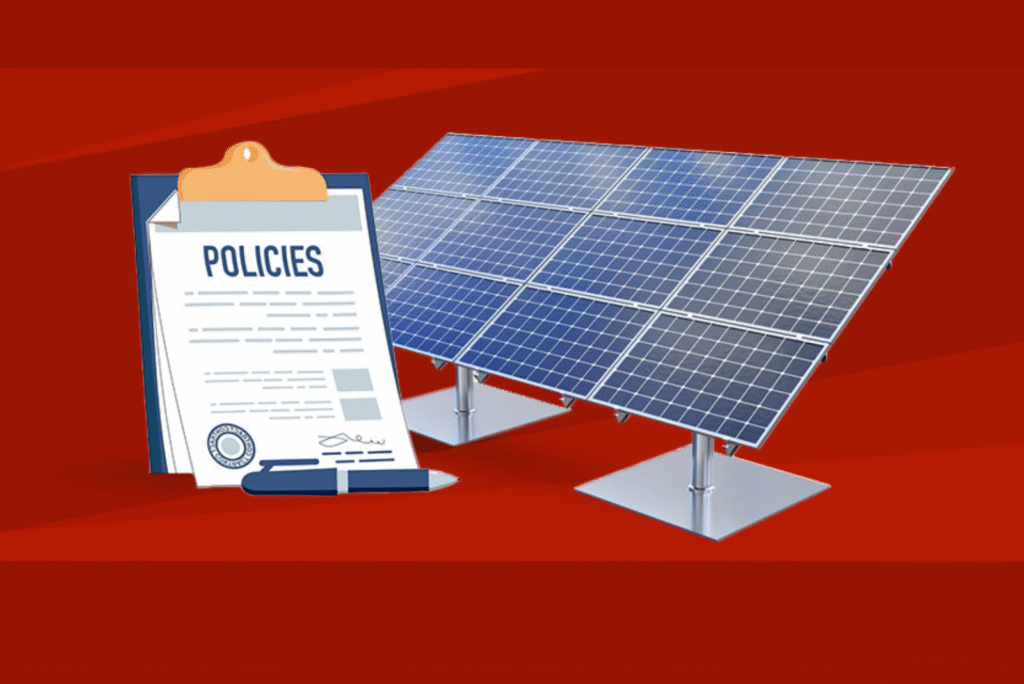
Solar Policy 2025 India Home Blogs Popular Posts All Posts Blog Seasonal Maintenance Tips for Solar… October 6, 2025 Solar Water Pump vs Regular… October 6, 2025 Rooftop Solar vs Ground-Mounted Solar October 6, 2025 Choosing the Best Solar Panel… October 6, 2025 Power Your Future with KLK Ventures Pvt. Ltd. Delivering reliable solar solutions for a sustainable tomorrow. Switch to clean energy and save with us today. Contact US India is now entering an important stage in its clean energy transition. The Solar Policy 2025 signals a fresh attempt to scale solar power in homes, farms, industries, and rural communities across India. Promising simpler processes, deeper incentives, and larger participation, it aims to be the most inclusive opportunity for installing solar energy in any community. Now let’s break down some of the highlights of this policy, who it affects, and why it matters to nearly every citizen of India. Why Solar Policy 2025 Is Game-Changing India ranks as one of the largest energy consumers in the world—despite much of that energy demand being met by coal—solar power is a best-ready alternative, especially since much of the country receives abundant sunlight throughout the year. The 2025 policy aims to: Accelerate India’s transition to clean energy Curb rising electricity costs and pollution Empower consumers—from farmers to homeowners Create green jobs across rural and urban India New Benefits for Rooftop Solar One of the standout features of Solar Policy 2025 is a renewed focus on rooftop installations. Homeowners and small businesses now enjoy: Increased subsidies under Surya Ghar Muft Bijli Yojana Easy online registration and faster approvals Multiple financing models including zero-EPC and EMIs For insights on the evolving technology landscape that supports these updates, read The Rise of Solar Technology in India, which explains how batteries, smart panels, and panels-as-roof systems are shaping adoption. Farmers to Gain from Policy Expansion Agriculture remains a high-priority sector in this policy refresh. The revamped PM-KUSUM scheme under Solar Policy 2025 offers: Simplified subsidy access for solar pumps and tube well systems Income opportunities from selling surplus electricity Support for collective solar mini-grid projects For deeper insights into how solar tubes and pumps transform irrigation, check our blog on solar tube‑well systems. This practical guide explains how clean energy brings both water security and cost savings to farmers. Encouraging Industrial & Commercial Solar Industries are expected to be strong beneficiaries of this policy update. Key incentives include: Capital subsidies and faster grid permissions Tax breaks and accelerated depreciation for solar investments Support for open-access models and shared solar parks Our Solar ROI for Businesses in India blog explores how this policy shift leads to faster returns and sustainability targets achieved through commercial solar adoption. Smarter Net Metering & Grid Integration A major reform under the 2025 policy is the unification of near‑net‑metering norms across India. This means: Greater credit for unused solar power Standardized billing cycles User-friendly apportioning of energy consumption and generation These reforms remove geographic inconsistencies and empower users to benefit equally, regardless of location or electricity board. Strengthening Rural Electrification Rural energy access gets a significant boost under the new policy: Funds for solar mini‑grids in off‑grid areas Kits for schools and health centers powered by solar Initiatives to train local youth as solar technicians Boosting Green Manufacturing & Jobs To reduce dependence on imports and support rural livelihoods, the policy includes: Production Linked Incentives (PLI) for solar panels and battery makers Special solar-focused manufacturing zones Skilling campaigns like Suryamitra and Skill India With solar manufacturing poised to generate over 1 million jobs by 2030, this push signals long-term growth. Final Thoughts Solar Policy 2025 India is a courageous movement toward a cleaner, self-supervising energy future. Whether you are a farmer, homeowner or entrepreneur, the opportunities are broad and convenient. With stronger incentives, standardised billing terms, storage assistance, and a solid rural and industrial strategy, India is boosting its global solar dominance. If you have been contemplating solar, this policy will deliver the stronger tools and easier access to action it is demanding.
Solar Energy for Agriculture
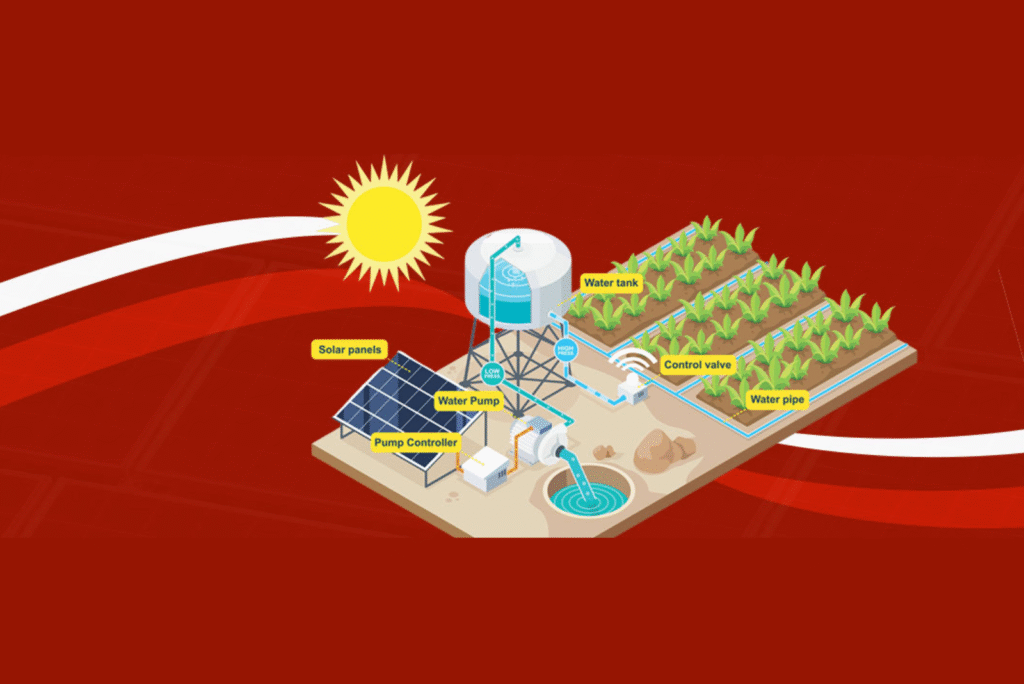
Solar Energy for Agriculture Home Blogs Popular Posts All Posts Blog Seasonal Maintenance Tips for Solar… October 6, 2025 Solar Water Pump vs Regular… October 6, 2025 Rooftop Solar vs Ground-Mounted Solar October 6, 2025 Choosing the Best Solar Panel… October 6, 2025 Power Your Future with KLK Ventures Pvt. Ltd. Delivering reliable solar solutions for a sustainable tomorrow. Switch to clean energy and save with us today. Contact US Farming in India is rapidly evolving. With increasing fuel prices and unreliable energy sources, more farmers are adopting solar energy systems. Clean, renewable, and inexpensive — and especially powerful in rural areas — it provides an alternative to diesel fuel and electric energy. Solar energy for agriculture isn’t just about going green — it’s about saving money, improving yields, and achieving self-sufficiency. It provides farmers with more productivity using fewer inputs, from irrigation to cold storage. Let’s look at the transition to solar energy in Indian agriculture. Why Solar Energy is Perfect for Indian Farmers India has over 300 sunny days a year. This makes it the ideal country to use solar energy on farms. Instead of depending on diesel pumps or grid electricity, farmers can use sunlight to power essential tools and systems. Key benefits: Works in off-grid rural areas Lowers electricity and fuel costs Reduces carbon emissions Makes farming more sustainable Supports government subsidy schemes By using solar energy, farmers can control costs and increase productivity without harming the environment. How Solar Energy is Used in Agriculture Solar energy is now used in many smart ways on Indian farms — from running water pumps to lighting storage sheds. These solutions help reduce fuel dependency and boost overall efficiency. Learn more about its practical applications in solar power for agriculture. There are many ways solar power helps farmers in their day-to-day work: There are many ways solar power helps farmers in their day-to-day work: 1. Solar Water PumpsOne of the most popular uses is for irrigation. Diesel pumps are expensive to run. Grid power is unreliable. But solar water pumps solve both problems. Benefits: Works anywhere with sunlight No fuel costs Low maintenance Long lifespan (15–20 years) To understand how these pumps work and their types, visit our detailed guide on what is a solar water pump and different types of solar water pumps. 2. Solar FencingSolar-powered fencing keeps crops safe from animals without needing grid power. Advantages: Prevents animal entry Charges automatically during the day Works well in forest-border areas Saves cost over electric fencing This is ideal for regions with wildlife or night-time crop raids. 3. Solar DryersPost-harvest losses can be high due to improper drying. Solar dryers help farmers dry grains, fruits, and vegetables quickly and hygienically. Why use them: Faster than sun drying Protects from insects and rain Increases product quality and shelf life Solar dryers help small farmers earn more from their harvest. 4. Solar-Powered Cold StoragePerishable crops like fruits and milk need cooling. In rural areas, solar cold storage helps preserve produce longer. Features: Runs fully on solar power Keeps temperature stable Reduces spoilage and waste Improves bargaining power for farmers Many FPOs and co-operatives are now setting up solar-powered storage units in villages. 5. Solar Lighting for FarmsLighting is needed for night work, animal care, and safety. Solar street lights and lanterns are a simple solution. Use cases: Cattle sheds Poultry farms Field boundaries Farmhouses How Much Can Farmers Save with Solar? Installing a solar pump may seem costly at first, but the savings over the years are significant. The cost of installing a solar water pump system in India depends on multiple factors like HP rating, panel type, and installation region. Thanks to subsidies and financing, it’s now more affordable than ever. Why it’s worth it: Zero fuel costs after installation No monthly electricity bills Less maintenance over the long run Pays for itself in a few years through savings With proper upkeep, a solar system can last well over a decade. Government Schemes That Support Solar for Agriculture India’s PM-KUSUM scheme and other subsidies are making solar systems more accessible for farmers. From eligibility to applying for a subsidy, you can explore the complete process in our blog on Solar KUSUM C Yojana benefits, eligibility, and application process. The Indian government supports solar adoption in farming through various programs. Key schemes: PM-KUSUM (Kisan Urja Suraksha evam Utthaan Mahabhiyan) Farmers get up to 30% support on solar pumps Encourages off-grid solar solutions Extra power can be sold back to the electricity board State-level schemes offering extra benefits in states like Maharashtra, Gujarat, and Rajasthan NABARD-supported loans for easier financing Net metering for earning credit on unused electricity These initiatives are making solar a long-term, low-risk investment for the agricultural sector. Challenges in Using Solar for Farming Challenge Solution High initial cost Use government subsidy and flexible bank finance Dust on panels Use solar cleaning systems to maintain output Lack of awareness Set up demo farms and local training sessions Technical breakdown Partner with experienced AMC service providers for routine checks Choosing the Right Solar System for Your Farm Before buying, farmers should check: Daily electricity or water needs Type of pump required (surface/submersible) Availability of rooftop or ground space Access to subsidies and support programs Warranty and post-sale services Future of Solar Energy in Agriculture The future of farming will depend on clean and smart energy systems. Upcoming trends: Solar-powered tractors and threshers Drip irrigation linked with solar sensors Community-based solar grids in rural areas AI tools that automate irrigation based on sunlight More awareness through government outreach and training Final Thoughts Solar energy in agriculture is no longer a “good idea” – it is becoming absolutely necessary for the future of farming in India. Solar energy provides a way for farmers to reduce their costs, boost production, and reduce their reliance on erratic grid power or expensive diesel. With increasing government backing, improvements in technology, and increasing awareness of the use of solar energy, it is a matter of time before solar-farming become
Solar Panel Efficiency
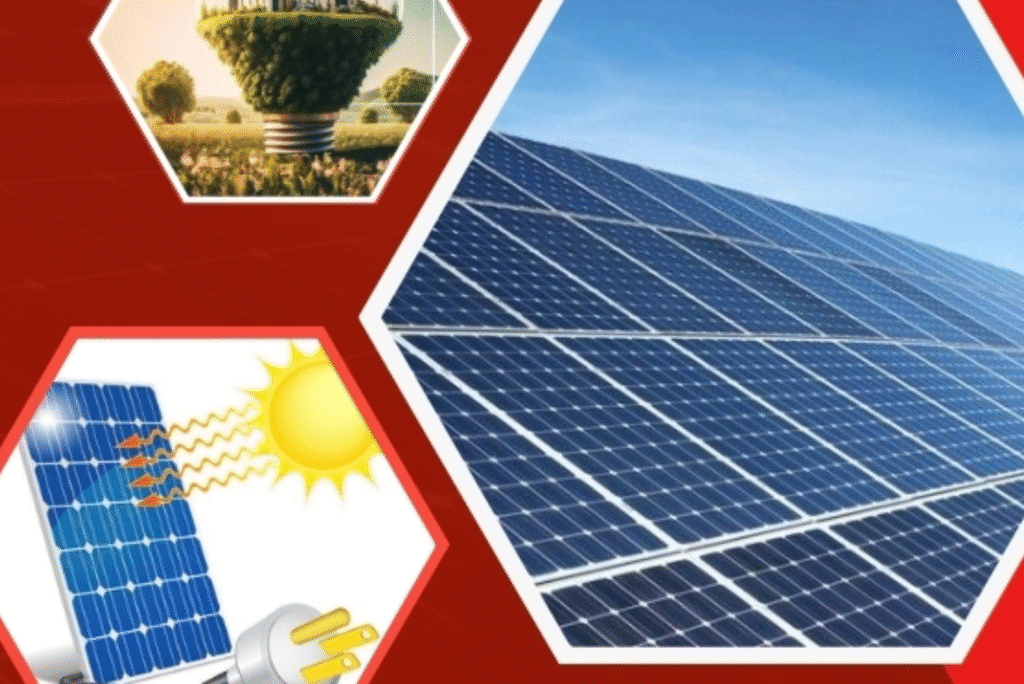
Solar Panel Efficiency Home Blogs Popular Posts All Posts Blog Seasonal Maintenance Tips for Solar… October 6, 2025 Solar Water Pump vs Regular… October 6, 2025 Rooftop Solar vs Ground-Mounted Solar October 6, 2025 Choosing the Best Solar Panel… October 6, 2025 Power Your Future with KLK Ventures Pvt. Ltd. Delivering reliable solar solutions for a sustainable tomorrow. Switch to clean energy and save with us today. Contact US Solar panel efficiency means how well your solar panels convert sunlight into electricity. The better the efficiency, the more electricity your system produces — even with limited space or sunlight. In a country like India, where the sun shines brightly most of the year, using efficient solar panels will save you more money, and better meet your energy needs. Let’s understand how efficiency works, what affects efficiency and how you may improve efficiency. What is Solar Panel Efficiency? Solar panel efficiency is measured by how much sunlight a panel can convert into usable electricity. For example, if a panel has 20% efficiency, it means 20% of the sunlight it gets turns into power. Typical efficiency range: Standard panels: 15%–22% High-efficiency panels: 20%–23% Why Solar Panel Efficiency Matters Efficiency directly affects how much energy your system produces — and how much you save. High-efficiency panels offer: More power from fewer panels Better performance in cloudy or hot weather Space-saving rooftop design Long-term cost savings Faster return on investment Choosing the right panel type can make a big difference in your monthly electricity bill. Factors That Affect Solar Panel Efficiency Several things impact how well your panels perform: 1. Panel TypeThere are mainly three types of panels: Monocrystalline – Most efficient (up to 23%) Polycrystalline – More affordable, moderate efficiency Thin film – Flexible but lower efficiency KLK rooftop solar systems often use high-quality monocrystalline panels for maximum output. 2. TemperatureSurprisingly, higher temperatures can lower efficiency. Panels work best in moderate climates with good ventilation. Solutions include: Mounting panels with airflow space Using cooling materials in the structure Avoiding dark rooftop materials that trap heat 3. Dust and DirtDirty panels can reduce output by 15%–25%. Regular cleaning is important. You can use automated solar panel cleaning systems to remove dust without wasting water. 4. ShadingShadows from trees, buildings, or poles reduce efficiency. Even partial shading can lower the output of the whole system. Use smart inverters with MPPT (Maximum Power Point Tracking) to reduce shading loss. 5. Panel Orientation and AnglePanels should face the right direction (usually south in India) and be tilted at the correct angle based on your location. Poor angle = less sunlight = less power. 6. Quality of InstallationEven the best panels will underperform if they are not installed correctly. Always work with trained professionals for secure mounting, wiring, and setup. Look for brands that offer solar structure solutions that fit your rooftop type and climate. How to Improve Your Solar Panel Efficiency Even if you’ve already installed a system, you can still improve performance with these steps: Clean panels every 2–4 weeks Trim trees or objects blocking sunlight Install reflective surfaces nearby to boost light Use smart inverters for better power tracking Upgrade to high-efficiency panels if needed Many users are now combining rooftop systems with solar batteries to store extra energy for night use. How Efficiency Affects Cost At first, high-efficiency panels may seem expensive — but they save more over time. Example: 10 normal panels = ₹1000/month saving 8 high-efficiency panels = ₹1200/month saving Less panels = less installation cost, faster return Common Myths About Solar Panel Efficiency Myth: Higher efficiency always means more savingsTruth: It depends on your usage, sunlight, and system size Myth: All solar panels perform the sameTruth: Panel quality, material, and brand make a huge difference Myth: Panels stop working after a few yearsTruth: Most good panels last 25+ years with proper care Real-Life Example Challenge Solution High setup cost Use government subsidies and EMIs Lack of awareness Promote demo projects and school programs Seasonal variation Use hybrid models (solar + wind + storage) Maintenance issues Use AMC services for regular checks Real-Life Example A family in India installed 5kW rooftop solar with standard panels. After one year, they upgraded to high-efficiency monocrystalline panels and added an automatic cleaning system. Results: 22% more electricity per month Monthly bill dropped from ₹2600 to ₹150 ROI time reduced by 1.5 years This shows that investing in quality pays off. Final Thoughts your power is. If you are considering a new system, or upgrading an old one, remember to focus on panel quality, good installation, and ongoing maintenance. If you get all of that right, you can have clean, reliable solar power for decades to come.
Green Energy Resources
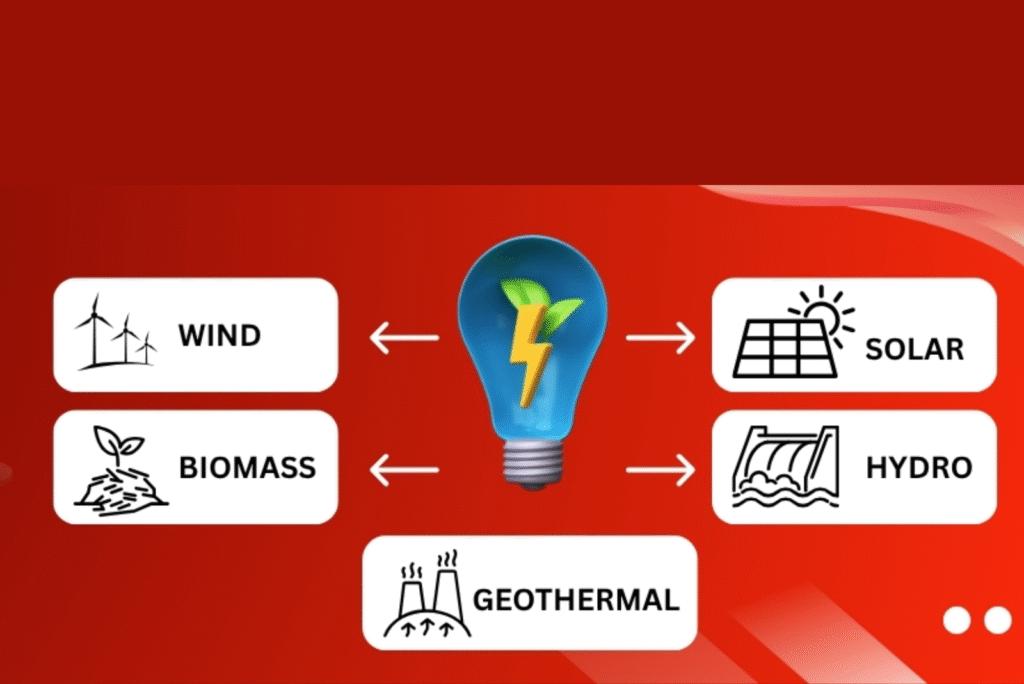
Green Energy Resources Home Blogs Popular Posts All Posts Blog Seasonal Maintenance Tips for Solar… October 6, 2025 Solar Water Pump vs Regular… October 6, 2025 Rooftop Solar vs Ground-Mounted Solar October 6, 2025 Choosing the Best Solar Panel… October 6, 2025 Power Your Future with KLK Ventures Pvt. Ltd. Delivering reliable solar solutions for a sustainable tomorrow. Switch to clean energy and save with us today. Contact US Green energy resources are natural sources of power that can be used without harming the environment. They are naturally replenishing, clean and unlimited, like sunlight, wind, water, and plants. As people look for viable ways to combat climate change, green energy is a necessity. India is rapidly growing green energy. It is a resource for households, farms, and businesses to save on electricity costs and become more sustainable. Let’s explore what green energy resources are and whether they are shaping the future. What Are Green Energy Resources? Green energy resources are energy sources that don’t harm nature. They release little to no pollution and are constantly available. These include: Sunlight (solar energy) Wind (wind energy) Flowing water (hydropower) Plants and organic waste (biomass and biogas) Earth’s heat (geothermal energy) Unlike coal and oil, these sources never run out and are safe for the environment. Why Green Energy Matters India is the third-largest energy user in the world. Most of its power still comes from fossil fuels, which cause pollution and global warming. Green energy helps us: Reduce carbon emissions Protect air and water quality Lower electricity bills over time Bring power to villages and off-grid areas Create new jobs in the energy sector Switching to green energy is not just smart — it’s urgent. Major Types of Green Energy Resources Let’s explore the most common green energy sources used in India and around the world. 1. Solar EnergyThis is the most used green energy resource in India. Solar panels capture sunlight and turn it into electricity. Benefits: Works well in sunny regions Can be used on rooftops and open fields Low maintenance Ideal for homes and commercial buildings KLK’s solar solutions help reduce electricity bills with long-lasting solar panels and support systems. 2. Wind EnergyWind turbines use the power of moving air to produce electricity. Where it works best: Coastal regions Open flat lands Hilltops States like Gujarat and Tamil Nadu lead in wind energy generation. 3. HydropowerHydropower uses flowing rivers or stored water from dams to spin turbines and generate electricity. Advantages: Clean and stable power Useful for remote hill areas Scalable for both small and large setups Hydro energy is already a big part of India’s clean energy mix. 4. Biomass and BiogasBiomass uses plant waste, wood, or animal dung to produce energy. Biogas is made by breaking down organic waste in closed tanks. Used for: Cooking and heating in rural homes Powering small engines Reducing kitchen and farm waste Biomass is an affordable green energy resource in many Indian villages. 5. Geothermal EnergyGeothermal energy comes from the heat stored deep inside the earth. Facts: Used more in countries like Iceland and the US India is testing it in areas like Ladakh and Himachal Pradesh Works best where underground heat is easily reachable Though still under development, geothermal has long-term potential in India. Benefits of Green Energy Resources Green energy is good for people, businesses, and nature. Here’s how: Reduces air and water pollution Supports rural development Improves energy security Cuts electricity bills Encourages clean industries Where Green Energy is Used Green energy is used across sectors: Homes: Rooftop solar, solar lights, and biogas for cooking Farms: Solar pumps, biomass dryers, wind turbines Factories: Solar rooftops, biofuel use, energy-efficient systems Cities: Smart poles, EV charging stations, and solar streets Even schools, hospitals, and railway stations are using green energy today. Government Support for Green Energy The Indian government is promoting green energy through multiple policies: Subsidies on rooftop solar and solar water heaters Net metering for households to sell back power Green Energy Corridor to transmit renewable power across states Renewable Energy Certificates (RECs) to promote clean energy among corporates PLI schemes to boost solar panel and battery production These steps are helping India move toward its clean energy targets. Common Challenges and Smart Solutions Challenge Solution High setup cost Use government subsidies and EMIs Lack of awareness Promote demo projects and school programs Seasonal variation Use hybrid models (solar + wind + storage) Maintenance issues Use AMC services for regular checks The Future of Green Energy in India Challenge Solution High initial cost Use subsidy and pay in EMI Seasonal reliability Add hybrid systems (solar + wind/battery) Low awareness Run local training and demo sessions Equipment failure Use AMC services for regular system checks Future of Renewable Energy Systems in India India aims to reach 500 GW of clean energy by 2030. With technology improving and costs dropping, green energy is set to power everything — from homes to highways. Future trends: AI-based smart grids Floating solar farms on lakes Battery storage for night use Solar-powered transportation More energy-efficient structures Final Thoughts The green energy resources provided by the environment are a gift to us. They are clean, safe, and full of potential. There is no limit to how beneficial even the smallest step toward green energy can be — whether it is a small solar light for your backyard or a massive wind turbine. Today, with strong government support combined with improved technology and incentives, going green can be easier than before. You can go on a small scale and grow from there — the future is powered by clean energy.
Renewable Energy System
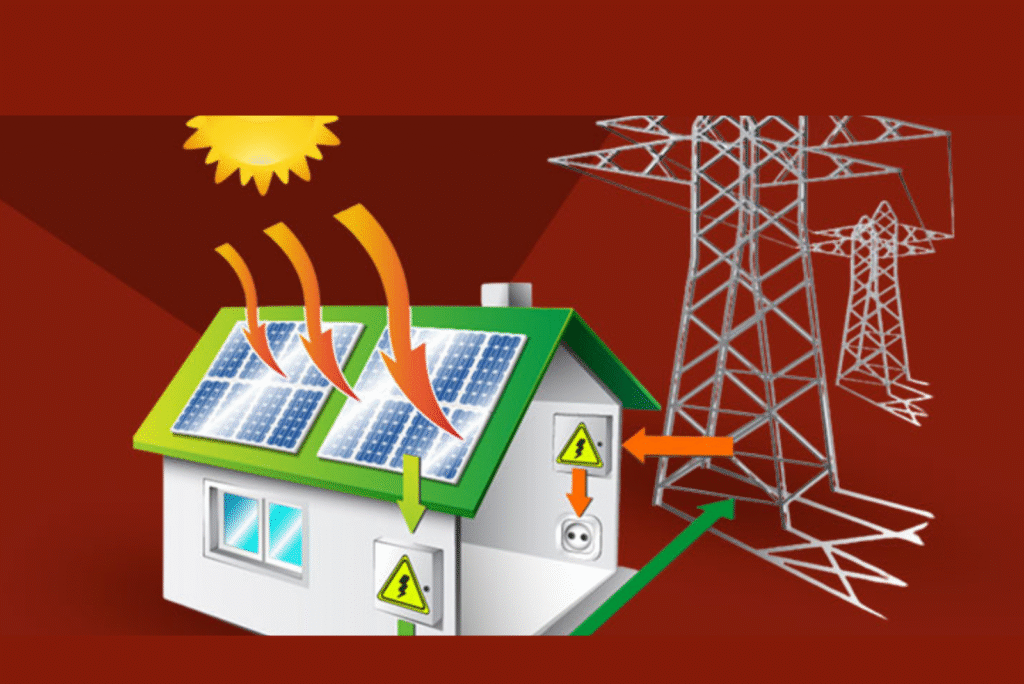
Renewable Energy System Home Blogs Popular Posts All Posts Blog Seasonal Maintenance Tips for Solar… October 6, 2025 Solar Water Pump vs Regular… October 6, 2025 Rooftop Solar vs Ground-Mounted Solar October 6, 2025 Choosing the Best Solar Panel… October 6, 2025 Power Your Future with KLK Ventures Pvt. Ltd. Delivering reliable solar solutions for a sustainable tomorrow. Switch to clean energy and save with us today. Contact US A renewable energy system is an assembly that harnesses nature’s sources, like sun, wind, or water, to create electricity. Renewable energy systems are gaining traction all over the world – for instance, India – as the demand for clean affordable power grows everyday. For homes, businesses, or industries too, renewable energy systems can help reduce power bills and pollution. Lets find out more about what a renewable energy system is, how they work, and why they are significant now. What is a Renewable Energy System? A renewable energy system includes all the equipment needed to convert natural energy (like sunlight or wind) into usable electricity. These systems can be small (for one house) or large (for an entire factory or village). They are: Eco-friendly – No harmful emissions Sustainable – Use energy sources that never run out Cost-effective – Save money in the long run Most systems include panels or turbines, inverters, batteries, and controllers. Types of Renewable Energy Systems There are many types of renewable energy systems depending on the energy source. Here are the most common ones in India: 1. Solar Energy SystemThis is the most common system. It uses solar panels to capture sunlight and convert it into electricity. What it includes: Solar panels (PV modules) Inverter to convert DC to AC Mounting structure Battery (optional) Charge controller Rooftop solar systems are now very common in homes and offices. Explore rooftop solar solutions that help reduce monthly electricity bills. 2. Wind Energy SystemThis system uses wind turbines to generate power. The wind turns the blades, which spin a generator to produce electricity. Common in: Coastal areas Open plains High-altitude zones like Gujarat and Tamil Nadu Wind systems are ideal for industrial sites with open land. 3. Hydropower SystemThese systems use flowing water – usually from rivers or dams – to turn turbines and generate electricity. Used in: Hilly areas Rural off-grid regions Small-scale village projects Some companies offer hybrid solar-hydro systems for continuous power supply. 4. Biomass and Waste-to-Energy SystemsThese systems use organic materials like crop waste or garbage to generate heat or electricity. They’re common in rural and municipal areas. Popular setups include: Biogas digesters Biomass boilers Waste-to-energy incinerators Check out waste management solutions that align with eco-friendly power generation. Components of a Renewable Energy System Each system has several parts that work together. Here’s what you’ll usually find: Energy source: Sunlight, wind, water, or biomass Collector device: Solar panel, wind turbine, hydro wheel Inverter: Converts energy into usable form Battery: Stores extra power for later Controller: Manages flow and protects equipment Support structure: Mounts panels or turbines safely For example, solar structures are designed to hold panels firmly on rooftops and withstand high winds. Benefits of Renewable Energy Systems These systems offer big advantages, especially in developing nations: Clean and sustainable Reduce long-term costs Great for off-grid villages Provide energy independence Encourage rural development Many farmers now use solar water pumps instead of diesel pumps for irrigation – saving money and reducing pollution. Where Are Renewable Energy Systems Used? They’re used in various settings: Cities: Rooftop solar in homes, schools, and hospitals Industries: Solar for factories, cold storage, and logistics hubs Rural areas: Wind and biomass for remote power Public places: Smart solar poles in parks and streets These systems are designed to be scalable – from one bulb to entire neighborhoods. How to Set Up a Renewable Energy System Here’s how to get started: Calculate your energy consumption Choose the right system based on location and weather Check rooftop or land availability Pick a reliable installer Apply for government support and subsidies Ensure regular maintenance You can start with custom energy audits to know what fits best for your needs. Government Support for Renewable Systems The Indian government provides: 30-40% subsidy on rooftop solar Low-interest loans for farm and home installations Net metering to sell back excess power PLI schemes for solar manufacturing State-level incentives across India Common Challenges and Solutions Challenge Solution High initial cost Use subsidy and pay in EMI Seasonal reliability Add hybrid systems (solar + wind/battery) Low awareness Run local training and demo sessions Equipment failure Use AMC services for regular system checks Future of Renewable Energy Systems in India Smart microgrids IoT-enabled energy monitoring Floating solar systems Energy storage solutions Hydrogen and hybrid fuel systems Final Thoughts A renewable energy system is more than a product; it’s a solution for clean, stable, affordable electricity. When powering your home, farm or office, renewable energy systems provide the resource, control, savings, that come with component controls, and peace of mind. Select the right system, accomplish the installation correctly, and you’re sure to enjoy clean electricity for years to come.
Renewable Energy in India

Renewable Energy in India Home Blogs Popular Posts All Posts Blog Seasonal Maintenance Tips for Solar… October 6, 2025 Solar Water Pump vs Regular… October 6, 2025 Rooftop Solar vs Ground-Mounted Solar October 6, 2025 Choosing the Best Solar Panel… October 6, 2025 Power Your Future with KLK Ventures Pvt. Ltd. Delivering reliable solar solutions for a sustainable tomorrow. Switch to clean energy and save with us today. Contact US India is transitioning from energy production through four different production mechanisms fossil fuel or biomass, toward cleaner sources of energy such as solar, wind, hydro or biomass, which is better for the environment and positive for the economic and job opportunity and life in general. Let’s explore why renewable energy in India is so significant, how it works and what the future holds. Why Renewable Energy Matters in India Renewable energy, on the other hand: Comes from natural sources like the sun and wind Never runs out Cuts down carbon emissions Lowers electricity bills over time Boosts rural employment and self-reliance In short, renewable energy helps India grow without damaging nature. Major Renewable Energy Sources in India India uses a mix of solar, wind, hydro, and biomass to meet its renewable energy goals. Each source has its own strengths and benefits. 1. Solar EnergyIndia gets bright sunlight for over 300 days a year, making solar power a top energy source. Key facts: Over 81 GW of installed solar capacity Top solar states: Rajasthan, Gujarat, Tamil Nadu Rooftop solar and large solar parks are growing fast Clean panels are more efficient. That’s why solar panel cleaning is important to maintain performance and output. 2. Wind EnergyWind turbines turn air into electricity. India is one of the top 5 countries for wind energy. Highlights: Wind energy capacity has crossed 45 GW Tamil Nadu, Gujarat, and Maharashtra lead in wind farms Monsoon season supports strong wind generation 3. HydropowerHydropower uses river and dam water to produce clean electricity. It’s a steady and well-established source. Hydro facts: Over 47 GW of large hydro capacity Common in Himachal Pradesh, Uttarakhand, and Northeast states Small hydro projects are helping remote hill areas 4. Biomass and Waste-to-EnergyBiomass energy comes from organic materials like crop residue, dung, and wood. Waste-to-energy plants turn garbage into power. Quick facts: Over 10 GW of installed capacity from biomass Biogas is widely used in rural kitchens Cities are building plants to convert waste into power Villages are also using solar smart poles for lighting and Wi-Fi powered by renewable energy. Government Support for Renewable Energy India’s transition to clean energy is very much driven by government policies and financial programmes to facilitate cost cuts and deployment of renewable energy at scale within states. The central and state administrations provide incentives, tax benefits and expeditious project approvals to stimulate public and private investment on renewable projects. Main initiatives: National Solar Mission (100 GW goal by 2030) Green Energy Corridor for modern grid upgrades Subsidies & Loans for rooftop solar and solar water pumps PLI Scheme to support local manufacturing of solar equipment Real-Life Renewable Energy Projects in India Clean energy projects in India highlight how scalable usage can be feasible and impactful. These projects are not just about the numbers but also about uplifting lives. Such initiatives illustrate that renewable energy can be integrated into public services, decrease pollution, and enhance communities’ energy access. Examples: Rewa Solar Plant, Madhya Pradesh – Powers Delhi Metro, reduces CO₂ Muppandal Wind Farm, Tamil Nadu – India’s biggest wind farm Kolkata Waste-to-Energy Plant – Transforms city waste into electricity How Renewable Energy Helps People Renewable energy has a real impact at the community level. It’s making daily lives better in a few different ways, including making electricity more reliable and reducing fuel costs. Clean energy also empowers women and students with lights in their homes, safer streets, and powered schools in remote areas. Benefits: Homes: Rooftop solar reduces bills and cuts power cuts Farmers: Use solar pumps for irrigation without diesel Businesses: Save energy costs and use industrial solar systems Challenges in India’s Renewable Energy Journey While the transition to a complete renewable future has certainly progressed, there are obstacles to overcome. Financial issues, seasonal barriers, and dated infrastructure impede forward progress. Public awareness campaigns and training programs are important bridging mechanisms between policy and practice for these towns, now specifically focused on Tier 2 and rural towns. Challenges include: High installation costs Battery storage limitations Seasonal variation in sun and wind Need for skilled workers Lack of awareness in rural regions The Future of Renewable Energy in India India’s future energy scenario unfolds elements of innovation, digital control, and sustainable design. Emerging technologies such as AI-enabled grids and floating solar parks are already being trialed. If R&D capital continues, India will be positioned not just as a renewable energy consumer, but rather as the premier exporter and innovator, globally. Trends to watch: Floating solar farms Smart grid technology Affordable solar batteries Green hydrogen fuel Goal: 500 GW of non-fossil fuel power by 2030 Tips to Get Started with Renewable Energy Initiating your clean energy journey is easier than ever. You can start small with rooftop solar or solar lights, then grow based on your requirements and savings. Use tools available to calculate how much energy you want, length of payback, available subsidies, and rebates like online solar calculators for your state for both your needs, usage, expenses and savings. Getting started: Track your current power usage Apply for available government subsidies Work with trusted vendors like KLK Ventures Consider net metering for extra savings Keep your system maintained and clean Conclusion For businesses looking to cut down on electricity bills and become more sustainable, investing in solar panels offers excellent ROI. It’s a smart long-term decision that not only saves money but also adds value to the company. Even if the upfront investment feels big, the returns — in savings, stability, and independence — make it fully worth it. Understanding your energy needs and evaluating available rooftop space
